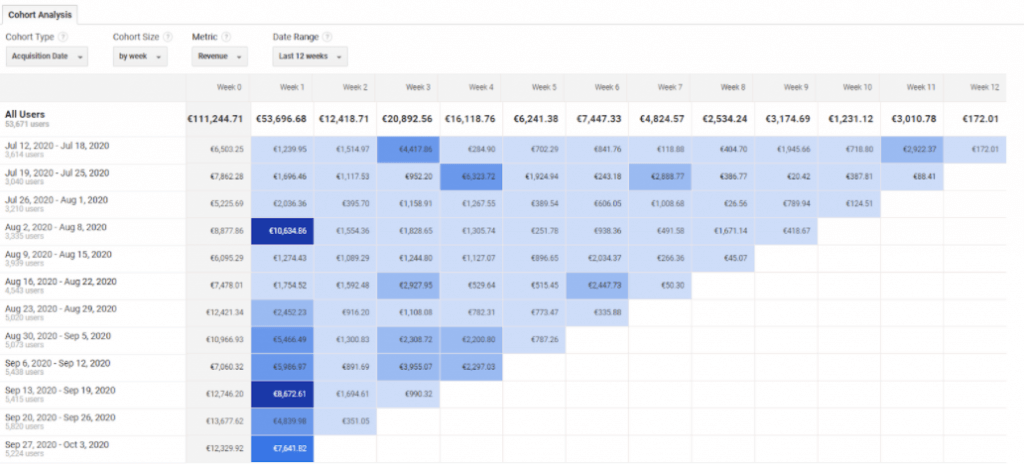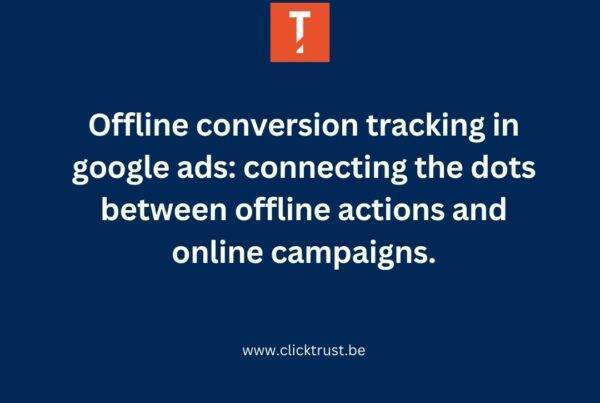Are repeat purchases a thing in your business? If so, you’re leaving growth on the table if you haven’t split your paid marketing campaigns between acquisition and retention. Paid media managers usually think that their campaigns are mostly bringing in new customers. But, we see that it’s often the other way around. Conversions in paid media campaigns are mostly done by existing customers. How can this be avoided? Well, you can split your campaigns. An example account structure in Google Ads would look like this:
Tip 1: Have an accurate view of customer lifetime value
If you want to push acquisition to the max (anything else should be considered underinvesting), you’ll need to have monitoring in place for customer lifetime value (LTV) and compare it to the cost to acquire new customers (CAC).
Tip 2: Have the proper KPIs and reports in place
While you’ll still need a report that consolidates your acquisition and retention campaigns, you’ll also need separate reports and KPIs. For acquisition, it’s all about bringing in new customers at a given cost per acquisition. You’ll need metrics like new customers, cost per new customer, and new customer conversion rate. Retention is about maximizing repeat purchases, so you’ll need metrics like impression share, transactions, cost per transaction, transaction conversion rate, and AOV.
Tip 3: Use the features that Google Analytics offers
Google Analytics has some great features and reports that you can easily leverage:
- User ID: Assign a unique user ID to website visitors that create an account. This will make sure that a maximum of sessions and customer journeys are unified so that you have the most correct data possible in Google Analytics. The user ID feature will also allow you to do some good analysis of the cross-device behavior of your existing customers.
- Cohort Analysis: This report is awesome. It allows you to track the cohorts of newly acquired customers so that you can check whether they’re doing repeat purchases as expected.
Tip 4: Expect repeat purchases to happen on other channels
Don’t make the mistake of looking only at what’s being attributed to the channel itself. Repeat purchases will happen through organic or direct, but they’re still part of the return on investment of the channel that initially brought in the new customer. You’ll need a holistic view, looking at total cross-channel performance.
Tip 5: Don’t think the juice isn’t worth the squeeze
Yes, your audiences will not be perfect because of cookies not being very reliable. Yes, the matching rate of customer match audiences is nowhere near perfect. But separating acquisition from retention campaigns is still worth the trouble. Whenever your digital campaigns and marketing funnels are being used to better match actual customer behavior, you’ll see improved performance. Having the proper reports and KPIs in place will also allow you to test new strategies and channels. E.g., A fun display campaign that didn’t perform well in terms of acquiring new customers might very well succeed in improving repeat purchase behavior.
Tip 6: Attribute appropriate value to branded campaigns in paid search
In most businesses, branded search campaigns don’t bring many incremental conversions. The exceptions are:
When competitors are bidding on your brand name
When you’re not ranking well organically for your brand name
For other businesses, branded search campaigns merely intercept conversions that would otherwise happen through organic or direct. So, attribute value to branded campaigns accordingly. In 95% of cases, it’s fine to disregard the conversions they bring in entirely.
Tip 7: Don’t use the same conversion for both acquisition and retention campaigns
Take into consideration the customer behavior and configure your conversion settings accordingly. It’s often required to have a duplicate of your hard conversion, but just with different conversion settings. For example, in acquisition, you don’t want to count several conversions because somebody can only become a customer once. But for retention, you do want to count several conversions, because repeat purchases can be made more than once, so it will give a more accurate view of the actual performance. To decide on the conversion window, look at the Time Lag report in Google Analytics and Path Metrics report in Google Ads. To decide on the attribution model per conversion, it’s usually fine to use a (mostly) first click-based model for acquisition and a (mostly) last click-based model for Retention. If you see that there is a long customer journey before the first hard conversion, you should look into optimizing your acquisition campaigns on a relevant soft conversion instead of on the hard conversion.
Tip 8: Leverage everything that you have to identify and target your client audience in the retention campaigns
Cookie-based audiences: Users that performed a hard conversion. Users that visited the “customer zone” pages, etc.
Customer Match audiences: With tracking cookies facing extinction (more on that in our paper on the death of cookies and the activation of CRM data), customer match audiences have become much more important. So, grab the email address and/or phone number that customers used when they made their first purchase. At first, a manual CSV upload should suffice. In a later phase, the upload can be automated with the Google Ads API or tools like Zapier.
Tip 9: Exclude client audiences from your acquisition campaigns
If you don’t specifically exclude the client audience from the acquisition campaigns, the acquisition campaigns can still match search queries done by clients when the ad rank is higher in the acquisition campaigns. Also, when using smart bidding, the algorithm will optimize toward better-performing signals and audiences. And guess what: the client audience will show better performance, so it will be favored by the algorithm.
Tip 10: Use different portfolio bidding strategies for acquisition and for retention
Usually, the goal of acquisition campaigns is to maximize new customers at a given maximum cost per new customer (CAC). So, a portfolio target CPA bidding strategy makes a lot of sense. You also shouldn’t care too much about the ROI of acquisition. It’s fine to not be ROI positive on the first purchase, as long as the repeat purchases make the ROI positive again. This is where the importance of being sufficiently aggressive in your retention campaigns comes in. You’re targeting and bidding on your existing customers, so you should be aggressive for several reasons:
The size of this audience is usually limited (unless you’re a huge business) so the budget requirement is also limited
Conversion rates on retention audiences are very high (don’t be surprised when seeing 30% or even 40%), so you can comfortably pay more for these clicks.
You don’t want to risk your existing clients going to a competitor because you weren’t present when the client did a generic search query. You already paid the acquisition cost for this customer, so it would be extra costly to see the client go to a competitor.
This is why we start out with a bidding strategy for retention that isn’t too conservative. A target search impression share in search or an aggressive manual bid is a good starting point. You can always test bidding less aggressively or being more selective in the auctions you want to participate in, by trying a value-based bidding strategy.
Recevez notre newsletter &
nos insights
Nous approfondissons les sujets brûlants du marketing numérique et aimons partager.




